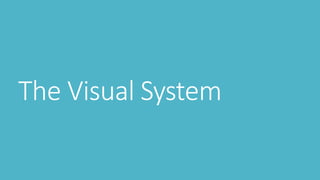The visual system begins with light entering the eyes and being registered by the retina. Optical information is sent via the thalamus to the primary visual cortex (V1) where initial processing begins. Signals then travel along two pathways - the ventral "what" pathway to the temporal lobe and dorsal "where" pathway to the parietal lobe. Damage to different parts of the visual system can cause blindness, visual agnosia, or visual neglect depending on the location of the lesion. Understanding the neurobiology of perception, memory, emotion and other functions is important for research in artificial intelligence.























